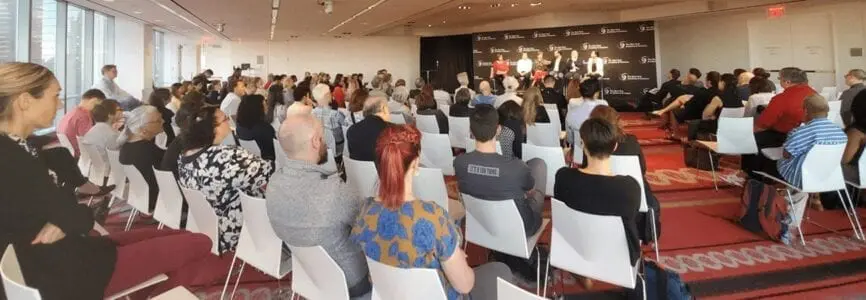Hastings Center News
Watch the Livestream: Genomics Enters the Clinic
Sixteen years after completion of the Human Genome Project, and more than half a century after the discovery of the structure of DNA, genetics is now being incorporated into clinical use. But as this new technology is integrated into mainstream applications, what do potential users of genomics need to know?
This question was the focus of a public event at the New York Academy of Sciences on June 11, presented by NYAS, The Hastings Center, and Aspen Brain Institute. Funding for this conference was made possible in part by the Donaghue Foundation. Watch the livestream here.
Hastings Center president Mildred Solomon moderated the discussion. Panelists were Josephine Johnston, director of research and a research scholar at The Hastings Center; Sandra Soo-Jin Lee, of Columbia University and a Hastings Center Fellow; Christopher E. Mason, of Weill Cornell Medical College; Jonathan Moreno, of University of Pennsylvania who is a Hastings Center Fellow; and Samuel Sternberg, of Columbia University.
“New genetic technologies, neuroscience, and advances in the life science are blending with advances in information technologies and artificial intelligence, and this blending is creating powerful synergies,” said Solomon in her introduction. “We have powers that earlier human beings never dreamed of, but that also means we have choices. This conversation will inform you about the science but also about the social and ethical implications of the science.”
A wide range of applications and potential applications of genomic science were discussed, including genomic sequencing in newborns, use of Crispr gene editing to prevent or treat genetic diseases in patients or to make changes that could be passed down to future generations, and the proliferation of direct-to-consumer genetic tests.
Regarding genomic sequencing of newborns, Johnston explained the reasoning behind recent recommendations from a NIH-funded project in which she was an investigator. The recommendations were not to sequence all newborns at this time, since the results would not be fully understood. However, the recommendations supported the use of genomics to aid in the diagnosis of sick newborns. “That’s the optimal context for using that technology,” she said.
.@bioethicsjosie advocates against compulsory newborn genome sequencing for reasons including: a lack of treatment options for many of the results, the removal of individual choice to learn about adult-onset diseases, drain on public health budgets, etc. @NYASciences #consumerDNA
— M Brickman Borchard (@MBrickmanPhD) June 11, 2019
Sandra Soo-Jin Lee discussed the public’s “growing appetite” for DTC genetic testing and the ethical concerns that it raises. “This isn’t just fee-for-service,” she said. “These companies are creating repositories of data to sell and share. Data can travel in ways that aren’t expected. What are our rights as consumers? There needs to be a robust conversation about it and how companies use our data and perhaps we should be demanding more accountability.”
“We’re paying them so that they can capitalize on our stuff,” Jonathan Moreno commented.
But there are signs of change. Christopher Mason cited two companies that have a more cooperative business model. “If you upload our data, you get a share in the company,” he said. “It’s a shift in the right direction.”
Follow the conversation on Twitter at #ConsumerDNA.

